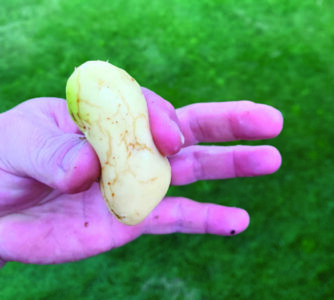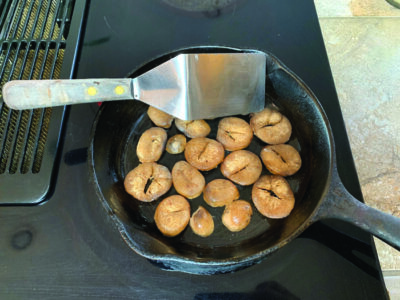This unique method for freeze-drying potatoes — which includes a fun chuno potato-peeling dance — will help you prolong your potato harvest.
Many of us might’ve made chuño, Andean-style preserved potatoes, without even knowing it. Every few years, you might be down in the basement storeroom or under the sink and find something rock-hard and shriveled that could be useful for scrubbing off callouses. “Oh,” you remark, “that must be a potato that missed the bin.” This unintended chuño potato might’ve gone bad in the process, turned mealy, and stunk to high heaven, but it also might’ve lucked its way through a few gradual drying steps and be quite comfortable staying like that for a decade. It may even be ready for reconstituting and cooking up into a delicious breakfast with some cheddar, chives, and eggs.
While it isn’t prudent to fish mystery relics off the cellar floor and start cooking them in hopes they won’t make you sick, intentionally drying potatoes is a terrific way to prolong shelf life if your harvest is going to be too big to consume in a season. People in the mountainous Andes region of South America have been deliberately preserving potatoes through a natural freeze-drying process since before “potato famine” became part of the lexicon. Incidentally, a horrific drought caused by a super El Niño event impacted the 1982 through 1983 growing season, and many a campesino made it through by dipping into the chuño stash. Here in North America, we might not have access to the astounding variety of specialty potatoes available in Peru and Bolivia, but we do have the means to preserve potatoes.
Start Freeze-Drying Potatoes
The result of this preservation process is a rock-hard whole potato that could be used as a makeshift hockey puck. When slowly reconstituted, however, it cooks beautifully in most potato dishes, and it has unique characteristics.
The hardness, of course, comes from a stunning lack of water on the inside of the tuber. Anyone who’s dehydrated food knows something as thick and wet as even a tiny potato doesn’t lend itself well to the drying process. This is where the chilly temperatures of the high Andean mountains come in. Once the weather is sufficiently cold (below 25 degrees Fahrenheit) at night, farmers spread their whole potatoes on the ground, spaced so the cold can crawl between them. Before they put the potatoes to bed, they sprinkle water over the harvest. Overnight, the spuds freeze hard and the frozen water within expands and breaks the cell walls. These ruptured walls are key to the preservation process, creating an exit path for the vast amounts of water that would cause your harvest to rot if it remained. While this can be done with larger potatoes, consider sectioning any potatoes larger than an egg.

When morning comes in that region, it’s often sunny. Between the sun, the elevation, and the cold, dry air, the frost that formed overnight on the potatoes quickly disappears. The potato itself has also undergone a change — its skin has wrinkled, and it’s gone from a hard lump to feeling like something you’d squeeze in your hand when you’re stressed. If you squeeze it after its first freeze, you’ll find that water dribbles out and keeps dribbling out. While your potato will squish, it has limits and will still contain quite a bit of moisture. Its wrinkly skin will also be loose, but not sloughing off.
These are important points; if the thawed potatoes retain spots that don’t feel squishy or where you can’t easily peel off the skin with your fingers, they haven’t frozen enough. When frozen, the spuds should sound like stones when you clink them together. A typical Andean freezing regimen before peeling is 4 to 8 days spread on the ground at night and then piled under a blanket during the daytime sun.
Alternative Techniques for Freeze-Drying Potatoes
Not everybody has a residence high up in the Andes, so let’s talk about alternative processing techniques. If you live in the dry American West, where winter temperatures drop below freezing at night and there’s cool daytime sun, you can probably make these the old-fashioned way. But if you live in Georgia, or want to try this during summer, you’re going to have to make some concessions for freeze-drying potatoes, the first of which is that you’re going to have to rely on Maytag to do the freezing.
Chuño Potato-Peeling Dance
After you’ve satisfactorily frozen and thawed your potatoes a few times, wring out excess moisture and remove the skin, which will keep it from acting as a moisture trap. You can peel it off by hand and squeeze really hard to get the moisture out, but another, perhaps more enjoyable, option is to roll up your pant legs and get some old-school chuño experience by performing the peeling dance.

For this dance, your partner is the pile of just-thawed squishy potatoes at your feet; rub and knead them with your toes in a sort of shuffle where you twist and step. Traditionally, this is done on a clean patch of dry grass, sometimes with straw spread over the top of the grass to make it softer and to allow the moisture to drain through without making a muddy mess. It’s also easier with the soon-to-be chuño in a small pile (maybe two dozen per pile).
There are a lot of reasons to do it this way. The straw helps with peeling, providing just enough abrasive grip to pull the clothes off the papas, which can get a little slippery in their birthday suits. The pile serves the same purpose, allowing the potatoes to rub against each other and peel themselves as they squish.

No matter how much or little you weigh, you’re probably going to be able to apply more pressure for longer with your feet than with your hands, and doing it with your hands feels like work, whereas doing it with your feet feels like fun.
If a clean patch of grass isn’t available, a shallow, flexible tote (something that won’t crack) is also a good place for the dance; just take some precautions so you don’t slip or trip, and lay down some cloth to soak up the juice.
There are about 2,000 varieties of potatoes out there, and the best ones for chuño (frost-resistant luki potatoes, Solanum juzepczukii) are loaded with alkaloids that make them taste bitter unless you leach them and slightly ferment them in cold, running water for about a month.
Swiftly after squishing, the peeled chuño hopefuls are typically bagged up in permeable bags (or dumped into big nets) that are submerged in high country rivers. The submersion, the temperature, the leaching, and the expediency with which they’re put in the water washes the product and delays discoloration, preserving that starchy whiteness a little longer.
If you don’t have an alpine river on hand, or just don’t want to go through the hassle because you don’t have bitter potatoes, skip the river: Immediately rinse off the straw and peels from your newly squished chuño potato candidates, and then freeze them again.

The steps you’ve taken up to this point have been pre-work. Next comes the actual drying, through a half-dozen or more freeze-thaw cycles until you have mummified remains. How close this comes to true freeze-drying (sublimation of ice to water vapor) is going to depend a lot on season and climate.
This process is meant for winter in high, dry areas, and the blazing summer sun will turn wet food into rotten mush if you don’t accommodate for local drying conditions. In the heat, freezing the potatoes again quickly after a brief thaw and dry will keep them from turning into tocosh (an odiferous fermented potato food) and will help minimize the normal discoloration that will penetrate from the outside of your chuño. You’ll get less discoloration the closer you come to mimicking freeze-drying, but don’t despair; your chuño negro (black chuño) is a legit food, and commercial chuño producers often rinse the potatoes in chlorinated water to get their product extra-white. You can shave off the darkened outer layer of chuño negro during the final stages of the drying process, similar to peeling a fresh potato. If you find yourself having trouble drying the last bit of moisture out of them, chopping them into smaller, thinner pieces will hurry the process along.
Go the final distance in a low-temperature dehydrator until your crop could be used as river rock props on a movie set. Properly dried chuño will clack together, just like when they were frozen. While they’ll shrivel some, they’ll retain some volume, and their insides will have a bit of porosity, whereas normally dried potatoes will look and feel solid.
Making a Meal out of Your Chuño Potato Stockpile
Ironically, having gone through all that desiccation work, you’ll have to undo it to make your product edible again. To prepare them, soak your preserved potatoes overnight in a bowl of water in the fridge. Change the water out three times while they’re soaking, and squeeze them out when they’re done soaking. Once rehydrated and sliced, they’ll bear an uncanny visual resemblance to mushrooms and an uncanny tactile resemblance to meat, and they’ll have a mouthfeel like a baked apple. These characteristics can be confusing, because they’re not typical of cooked potatoes. Getting a feel for how much to cook them is best done empirically the first time; these are a bit of a different animal than you’re used to, and you’re going to have to decide how you like this new food.

Chuño is amazing boiled in a small amount of milk with cheese melted in, or fried up and turned into a breakfast scramble with eggs and cheese. We’re also deep into soup season, and it’s hard to mess up a stew. A traditional stew, called carapulcra, is made of chuño or papa seca (dried potato), cinnamon, cumin, onions, peanuts, broth, wine, and meat. If you really want to get in on the action that fueled the Incan empire, that meat is llama jerky, but I’ll stick with pork.
Anything with this many steps has a tremendous opportunity to go sideways. If you want to find out if this food is for you without having to go through the trouble of a weeklong process, or if your results are questionable, commercial chuño is available online from specialty stores. A package of chuño blanco (white chuño) can be found online for under $20 plus shipping. But if you’re up for the challenge, the ability to prolong your potato harvest is just a peeling dance and a few freeze-thaw cycles away.
Josh Lau is an engineer, inventor, and Eagle Scout. He raises chickens and steers on a small ranch in Central Oregon with his patient wife and awesome kids.







